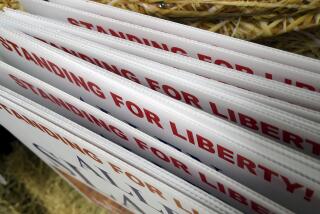Some Democrats Also Try to Ride Bush’s Coattails
WASHINGTON -- Although he’s not on the Nov. 5 ballot, President Bush is popping up in campaigns all over the country -- in person, in pictures and in printed words. And not just on behalf of Republicans.
In a testament to Bush’s popularity in the polls, Democrats from the West to the Farm Belt to the Deep South also are associating themselves with him on a variety of domestic and international issues, using his images and utterances in their own campaigns.
These Democrats include Sens. Paul Wellstone of Minnesota and Tom Harkin of Iowa. The two prairie populists strongly disagree with the president on most issues, but have highlighted Bush’s praise for their work in this year’s passage of a farm bill that significantly increased federal aid to agriculture.
Like Democrats across the country, Wellstone and Harkin ferociously oppose much of Bush’s agenda, especially his economic priorities. But they and other Democrats are trying to benefit from Bush’s high poll ratings -- fueled by his role as commander in chief in the war on terrorism -- for a simple reason: Almost without exception, they represent a district or state that Bush won or narrowly lost in 2000.
“It makes perfect political sense. Democrats in these states need to make voters believe that it is not necessary to vote Republican to back Bush,” said Larry J. Sabato, a political analyst at the University of Virginia.
Bush, of course, hopes that voters think otherwise. To that end, he has devoted much of his time to traveling the country on behalf of GOP candidates -- an effort that will accelerate in the next two weeks.
Bush’s prominent role in the midterm elections, including his prodigious fund-raising, bears implications for his expected reelection bid. A big day for Republicans on Nov. 5 would lend him the aura of a popular leader with impressive coattails and help him build momentum toward 2004. A GOP-controlled Congress also would revive key parts of his agenda -- such as further tax cuts -- that are stalled in the Democrat-controlled Senate.
But the president’s political strategists already are laying the groundwork for Bush to assert a modicum of victory -- for himself and the party -- even if the GOP were to lose control of the House and fail to recapture the Senate.
In most midterm elections in a president’s first term, his party loses an average of 30 House seats; no analyst expects that to happen this year.
“We are in a position, we think, to potentially defy history -- and thereby make history,” said Ken Mehlman, the White House political director. “Historically, the president’s party takes a drubbing in off-year elections. So if we don’t take a drubbing, that will be a positive statement.”
The numbers would seem to back up Mehlman. In the latest Gallup Poll, which is consistent with many others, Bush enjoyed a 62% approval rating and a 28% disapproval rating. At the same point in their presidencies, Ronald Reagan’s approval-disapproval numbers were 42% and 48%; Bill Clinton’s 40% and 51%. The last president to enjoy a popularity rating above 60% at about the same point was John F. Kennedy, and that was after a peaceful resolution of the Cuban missile crisis.
In 1982 and 1994, respectively, Reagan and Clinton were roundly attacked during the midterm election campaigns. Reagan called on the electorate to “stay the course.” Many Democrats ran against Reagan by calling for change. The Democrats gained 26 House seats, though they lost one Senate seat.
In 1994, Republicans all over the country used “morph” ads, with depictions of Clinton that faded into the likeness of the local Democratic candidates. The GOP gained 52 House seats and eight in the Senate, sweeping to control of both chambers.
Seen in that light, the current embrace of Bush by some Democrats running for reelection is remarkable. “There is no other recent comparable midterm election,” Sabato said.
In Montana, which Bush won by 25 percentage points in 2000, Democratic Sen. Max Baucus in one ad focused on his defense record and his efforts in helping “pass the president’s defense budget.” In Louisiana, which Bush won by 8 percentage points, a Democratic ad boasted that Democratic Sen. Mary Landrieu voted with the president 74% of the time -- including for his 10-year, $1.35-trillion tax cut.
In Georgia, which Bush won by 12 percentage points, Democratic Sen. Max Cleland took out an ad highlighting his support of Bush’s efforts to make air travel more secure after the terrorist attacks.
Seeking reelection as Georgia’s governor, Democrat Roy Barnes has used photos of himself with Bush and claimed that he patterned his own education reform bill after the plan Bush pushed through in Texas. In a House race in Utah, which Bush won by a whopping 41 percentage points, Democratic Rep. Jim Matheson has campaigned as an “independent voice” and emphasized his support for Bush’s tax cut and the president’s education reforms.
In South Dakota, which Bush carried by 22 percentage points, Democrat Sen. Tim Johnson -- who faces a Republican personally recruited by the White House -- has touted his vote for an array of administration priorities, above all the tax cut.
In Minnesota, which Democrat Al Gore won by 2 percentage points in 2000, Wellstone’s campaign displayed on its Web page a photo of the senator with Bush at the May 13 signing of the farm bill.
But a campaign spokesman added, almost apologetically, “we’re certainly not running on his friendship with Bush.”
In Iowa, which Gore won by a single percentage point, Harkin’s campaign also has used a photograph featuring Bush from the signing ceremony.
“The reason they do this is that swing voters love to see themselves as voting for the person, not the party. And some take it as a point of pride that they do not vote party lines,” said Washington-based independent political analyst Charles E. Cook Jr.
More to Read
Get the L.A. Times Politics newsletter
Deeply reported insights into legislation, politics and policy from Sacramento, Washington and beyond. In your inbox three times per week.
You may occasionally receive promotional content from the Los Angeles Times.










